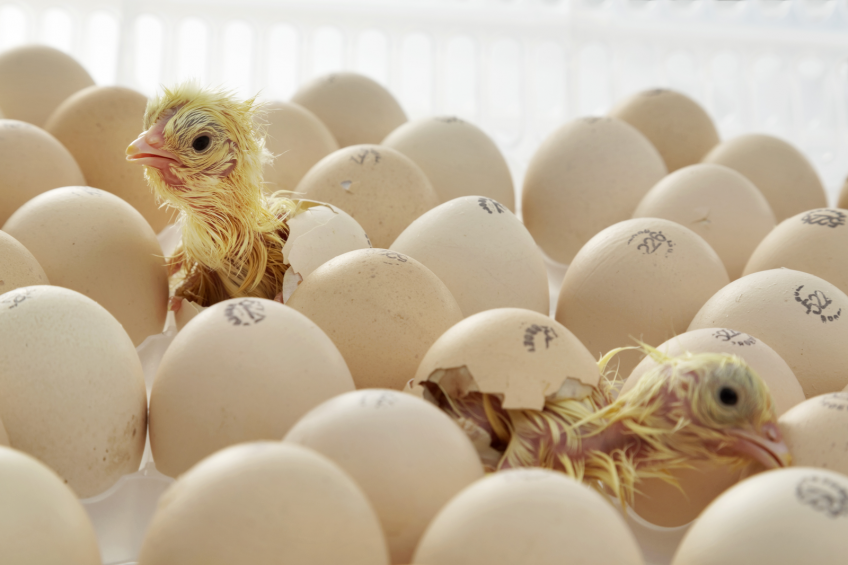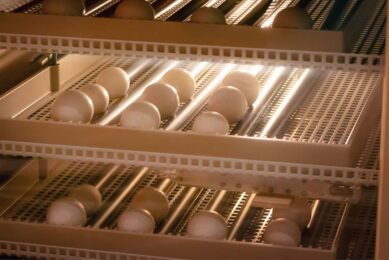The beautiful mystery of hatching

The hatching process is a beautiful process. In just three weeks, an egg transforms from what is essentially similar to a fertilised table egg into a live, complete chick. The climax of this transformation – through the ?hatching of the chick – occurs in the dark, behind closed doors. The beauty and relevance of the hatching process, is however not something that should remain behind closed doors.
As incubation draws to an end, the chick starts to fill the egg nearly completely. However, this is not the most important trigger for the start of the hatching process. Around day 18 of incubation, the chick starts to retract the residual yolk into its body cavity. Up until that point, the embryo has used the chorio-allantoic membrane (CAM) for respiration, diffusing CO2 and O2 through the eggshell and the CAM. However, oxygen demand in the embryo is increasing as it grows and because it becomes more active while supply from just the CAM is running short.
Internal pipping – chick embryos begins lung ventilation
The shortage of oxygen triggers the embryo to start lung respiration. The embryo instinctively puts its head under its right wing, with the beak pointing toward the membrane separating the egg contents from the air cell. At on average 19 days and 12 hours of incubation, the embryo pierces the inner membrane and starts lung ventilation in the air cell. This is called internal pipping. Even though the first lung respiration has started, the CAM remains important for respiration until up to day 20 of incubation. Internal pipping cannot be seen from the outside of the egg, but it can be detected by candling an individual egg with a torch. Furthermore, the embryo may have started clicking or peeping – in this way embryos can even communicate with each other while still inside the egg. If the hatching environment is quiet, they can trigger each other with these sounds to start the hatching process.
External pipping – art of the chick breaking through the shell
About 12 hours after it has pierced the inner membrane, the embryo starts tapping the eggshell repeatedly with its egg tooth, a sharp and strong structure that can temporarily be found on the top of the beak of the embryo. Repeatedly tapping the eggshell in the same spot causes the shell to weaken and eventually break. This is called external pipping. Pipping demands great effort. The pipping muscle, a neck muscle used to make this specific movement, is bulging by the time the embryo has finished hatching. From the outside, a small star-shaped crack or hole in the eggshell can be observed, sometimes with the point of a beak sticking out.
The hatcher doors are normally not opened during the hatching process to prevent disturbance of the hatching climate.
Hatching: the chick breaks free of the shell
After external pipping, the embryo takes a rest. It has one last challenging task ahead: breaking free from the eggshell – and it normally takes another 12 hours after external pipping to hatch. To do so, the embryo starts cutting the eggshell with the egg tooth. While cutting, the embryo turns around inside the egg, using its wing for direction and legs as the driving force. Once it has cut a 3/4th circle in shell of the blunt end of the egg, the embryo tries to push itself out of the egg by forcefully stretching its legs. Eventually, this will cause the last bit of the shell cap to break loose, allowing the embryo to push itself free. Newly hatched chicks look very wet, tired, and vulnerable. A while after hatching, their down feathers dry, they become fluffy and after they recovered from the hatching process they become more active.
The hatcher is normally not opened for pull until nearly all chicks are hatched and dry. Depending on the hatch window, pull time can be as late as 30 hours after the first chick has hatched. As a consequence, hatchery personnel rarely get to witness the beautiful hatching process because a traditional hatcher is completely dark and closed. The hatcher doors are normally not opened during the hatching process to prevent disturbance of the hatching climate. Therefore, personnel will not see how the eggshell is pipped, how the embryo works at further breaking away the eggshell, how it hatches and dries, and how it will become active and search for feed and water.
Hatching process made visible
HatchTech believes the hatching process is beautiful and worth witnessing. Watching a hatching egg transform into a complete, healthy, profitable chicken shows the core of the hatchery business. HatchCare is HatchTech’s new hatcher with feed and water available immediately post-hatch. It is fully illuminated with LED light for the benefit of the chick, but this also allows the hatchery personnel to see inside. The doors of the HatchCare sections are transparent and the HatchCare Care basket is specifically designed with see-through sides. As a result, both the eggs and the hatched chicks can be observed without the need to open a door and disturbing the chicks and the hatching climate. Not only will this make the hatching process visible and real, it also allows for easy monitoring of the hatching process, hatch window, and start of feed and water intake. This information will teach you valuable lessons about your incubation procedure and hatching conditions.
We believe that observing the hatching process in HatchCare will show the importance of an optimal, stress-free environment for the embryo and post-hatch chick, resulting in superior chick quality.
This article was featured in World Poultry magazine no. 2, 2015, to read more articles see our digital magazine
Join 31,000+ subscribers
Subscribe to our newsletter to stay updated about all the need-to-know content in the poultry sector, three times a week. Beheer
Beheer








 WP Admin
WP Admin  Bewerk bericht
Bewerk bericht